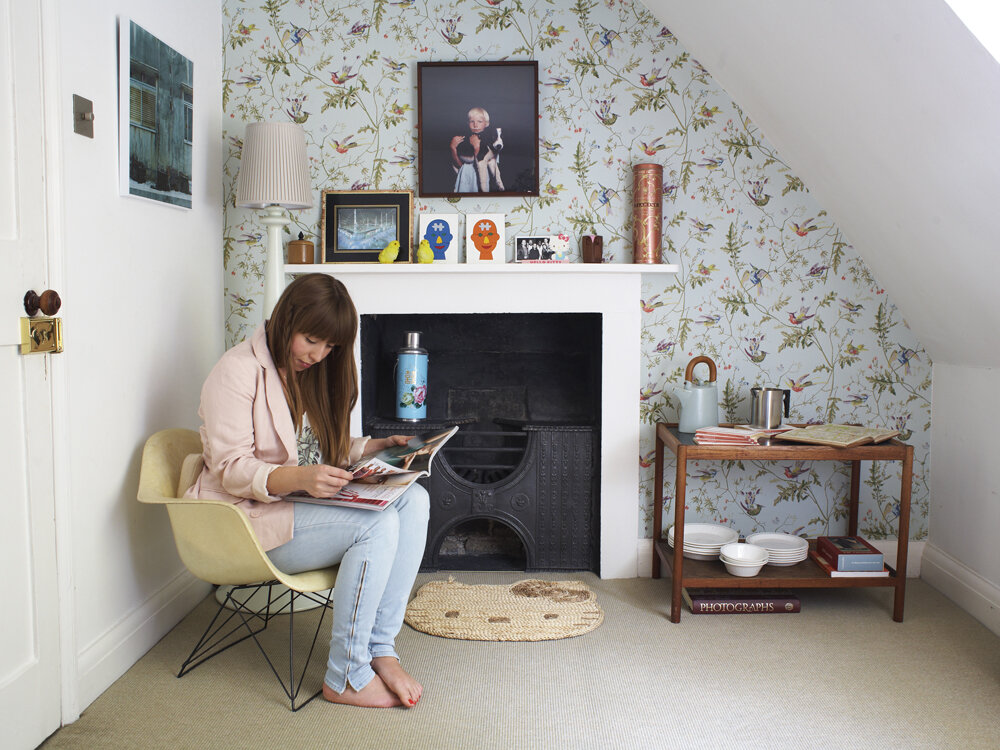spaces - a book by frankie press
Frankie magazine's project SPACES is a collection of eclectic interiors from around the world. This large-format mag explores the homes, studios, shops and cafes of graphic designers, photographers, vintage collectors and shop owners. Lizzie was approached by Frankie and asked if she'd like her home and shop to be included. She said yes. Words Benjamin Law. Photographs Hilary Walker. 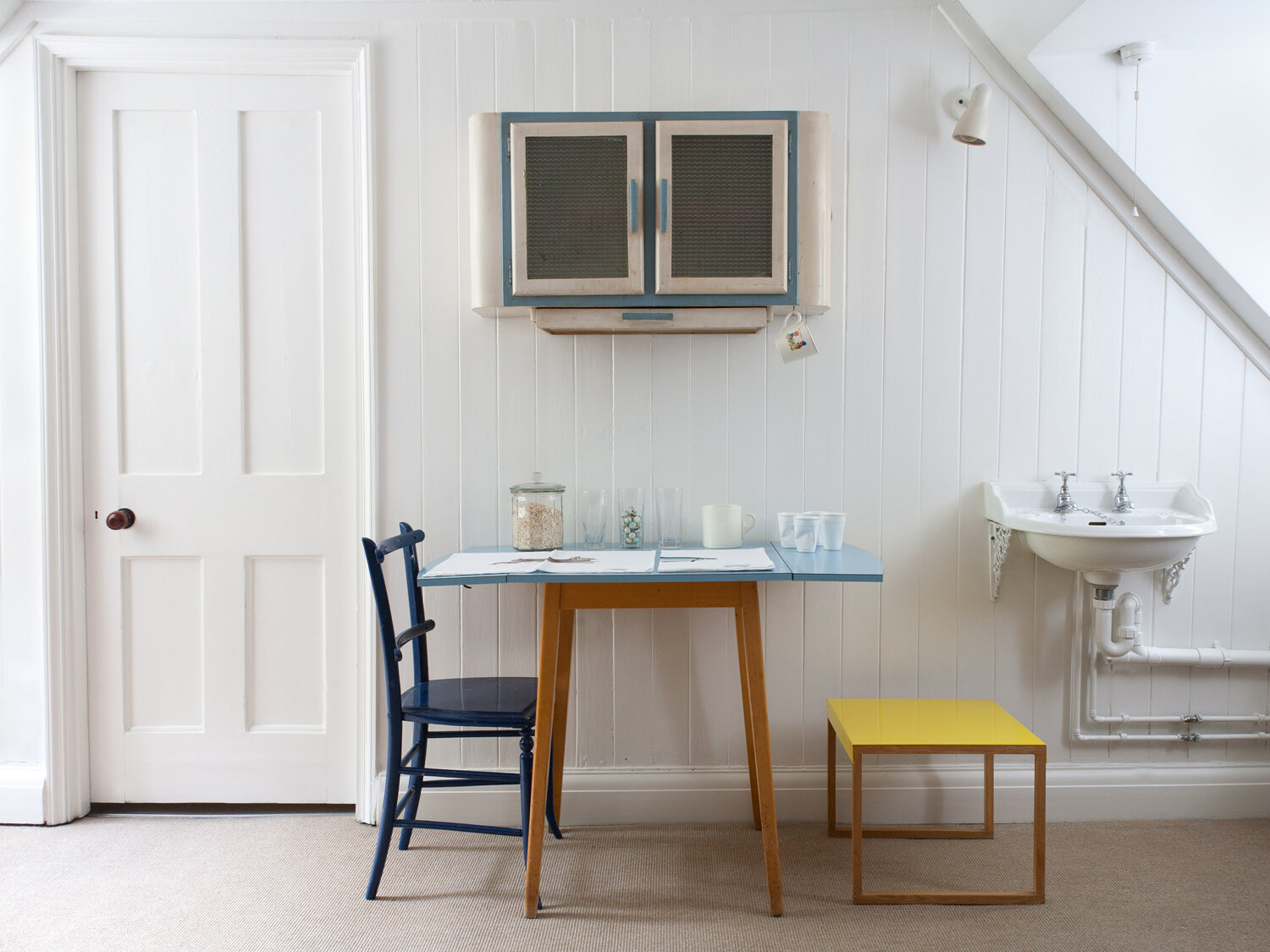 At an age where other girls were obsessed with music, clothes and mobile phones, Lizzie Evans was begging her folks for something different: a set of 3x4 flat-lying lockers with individual square doors. They were soft blue, a little rusty around the edges and old as all hell. Lizzie pleaded her case to her family, and it arrived soon after as a birthday present.Now 27 and an interior architecture graduate from london metropolitan university, Lizzie still cherishes the same locker set. (It’s the piece of furniture she wakes up next to every day, and stands right next to her bed.) That early, innate love of interiors and design has also led her to start up her own shop called SMUG in Camden passage, the same cluster of London alleys where Lizzie first laid sight on those lockers a decade ago.
At an age where other girls were obsessed with music, clothes and mobile phones, Lizzie Evans was begging her folks for something different: a set of 3x4 flat-lying lockers with individual square doors. They were soft blue, a little rusty around the edges and old as all hell. Lizzie pleaded her case to her family, and it arrived soon after as a birthday present.Now 27 and an interior architecture graduate from london metropolitan university, Lizzie still cherishes the same locker set. (It’s the piece of furniture she wakes up next to every day, and stands right next to her bed.) That early, innate love of interiors and design has also led her to start up her own shop called SMUG in Camden passage, the same cluster of London alleys where Lizzie first laid sight on those lockers a decade ago. 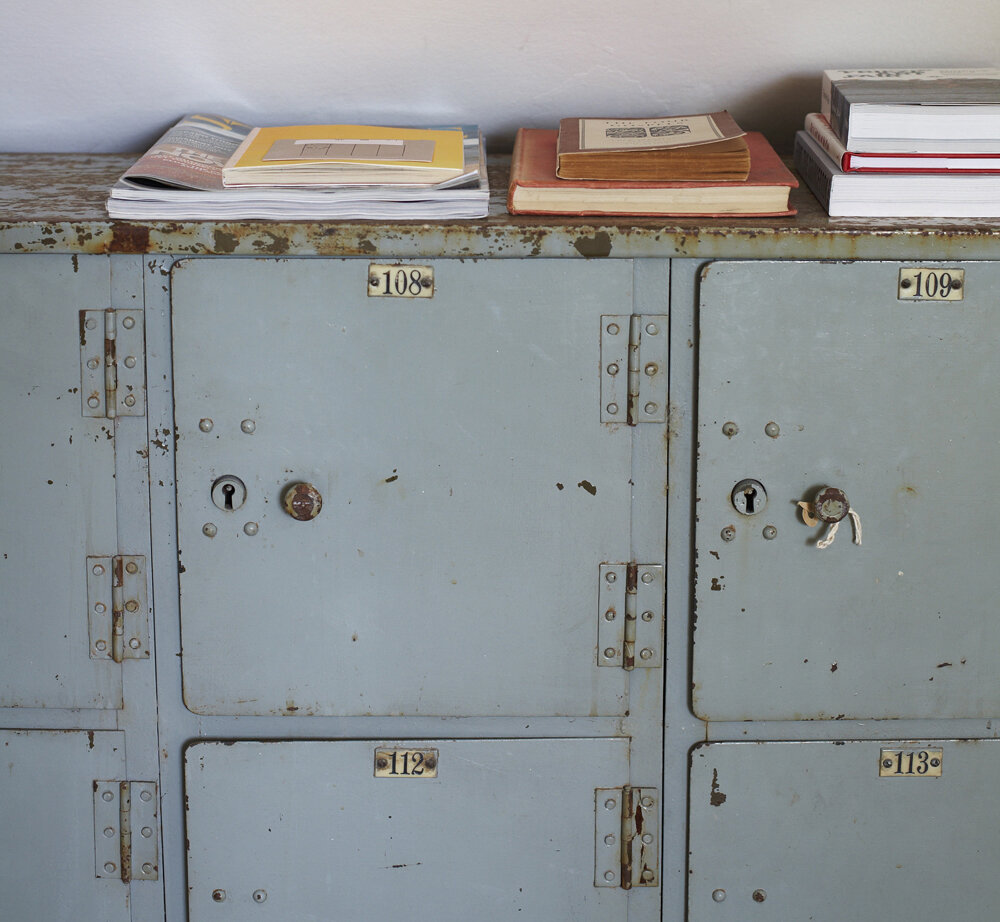 SMUG is a grab bag collection of homewares, furniture and gifts, and gives Lizzie the opportunity to showcase what she calls her “favourite things from all over the world”. Different customers like different things. Couples in their 30s love their homewares, professional designers adore the original 1950s furniture, young mothers go for handmade toys, while senior ladies love the hand-blown glassware. Items range from £2 all the way up to £600. “People who don’t have loads of money still feel they can have a part of SMUG,” Lizzie says. The building was originally an ancient overspill of an antiques clock shop, and took a lot of work to knock into shape. “I bought the building a couple of years ago, completely took it apart and put it back together again,” she says. “It wasn’t set up as a shop at all. It was a decrepit, crumbling shell with carpet up the walls. It was basically storage, kind of rotten, mouldy and falling apart. Just dreadful.” Some of the staircases even fell through, and Lizzie discovered they were eaten away with decay. “We’ve done loads to get all of the light in, used lots of glass and metal, and changed it quite a lot,” she says. “But we’ve also kept some of the original features, like some of the nice wooden floorboards and the manhole covers in the basement.” Some of the overhauls were major, which is obvious when you see how SMUG uses glass. From the outside, SMUG’s storefront is entirely transparent, and because the ground floor is slightly raised, passers-by see right into smug’s kitchenware-filled basement.
SMUG is a grab bag collection of homewares, furniture and gifts, and gives Lizzie the opportunity to showcase what she calls her “favourite things from all over the world”. Different customers like different things. Couples in their 30s love their homewares, professional designers adore the original 1950s furniture, young mothers go for handmade toys, while senior ladies love the hand-blown glassware. Items range from £2 all the way up to £600. “People who don’t have loads of money still feel they can have a part of SMUG,” Lizzie says. The building was originally an ancient overspill of an antiques clock shop, and took a lot of work to knock into shape. “I bought the building a couple of years ago, completely took it apart and put it back together again,” she says. “It wasn’t set up as a shop at all. It was a decrepit, crumbling shell with carpet up the walls. It was basically storage, kind of rotten, mouldy and falling apart. Just dreadful.” Some of the staircases even fell through, and Lizzie discovered they were eaten away with decay. “We’ve done loads to get all of the light in, used lots of glass and metal, and changed it quite a lot,” she says. “But we’ve also kept some of the original features, like some of the nice wooden floorboards and the manhole covers in the basement.” Some of the overhauls were major, which is obvious when you see how SMUG uses glass. From the outside, SMUG’s storefront is entirely transparent, and because the ground floor is slightly raised, passers-by see right into smug’s kitchenware-filled basement. 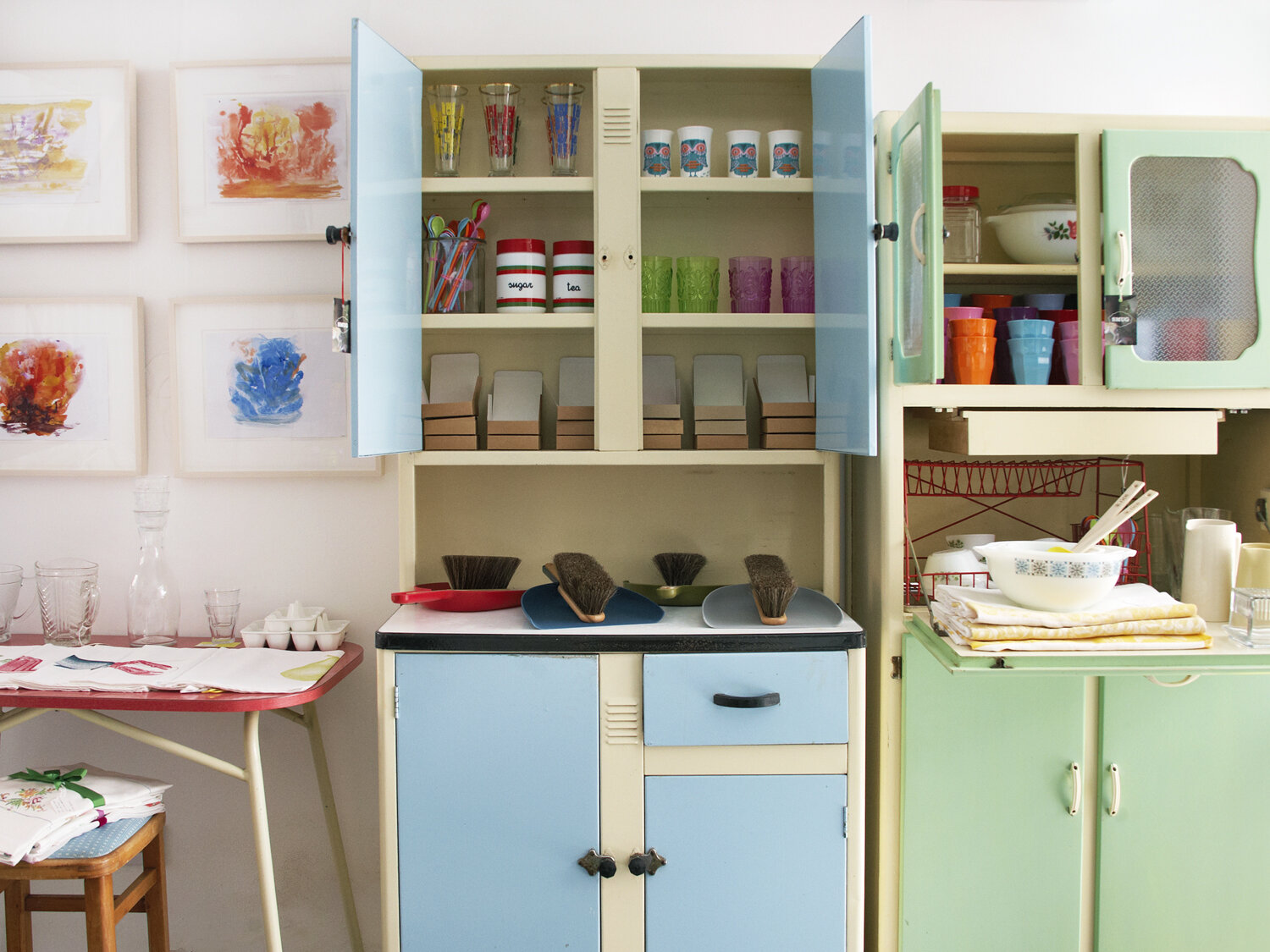 “It works quite nicely,” Lizzie says. “although, some people do come in and go, ‘how do I get downstairs?’ They have to walk to the back to get down, and they get very confused, but it looks really cool.” Glass is used cleverly inside too, with the floor around the front till completely see-through to make the outside display appear as though it’s hovering. However, that sleek sense of style is also coupled with the homely cosiness of her stock. For Lizzie, that’s important. “Lots of interior design shops in London that I love are quite minimalist and masculine, but don’t have much atmosphere other than it being impressive. What people enjoy about SMUG is it’s a bit more quirky and a funny mix of things. They like to stay for quite a long time.” SMUG is also super-specific with its range of stock, choosing to align itself with a particular colour palette lifted from 1950s formica interiors. “It’s a particular blue, it’s a particular yellow and a red,” Lizzie says, “but there are also the wooden legs and chairs, so there’s tawny brown too.“In the ‘50s, they used colour so beautifully. They’re quite bright colours and it’s a statement, but they managed to be very neutral with the wood in your home. I feel we’ve never been able to do it as well since. Nowadays, everybody has to have wood or white. In the ‘50s, they worked with colour, so that this colour palette would go anywhere perfectly. That’s what excites me about it. Even just the material of formica and the slight sheen on it, that even when it starts crumbling and decaying slightly, it’s still beautiful.”
“It works quite nicely,” Lizzie says. “although, some people do come in and go, ‘how do I get downstairs?’ They have to walk to the back to get down, and they get very confused, but it looks really cool.” Glass is used cleverly inside too, with the floor around the front till completely see-through to make the outside display appear as though it’s hovering. However, that sleek sense of style is also coupled with the homely cosiness of her stock. For Lizzie, that’s important. “Lots of interior design shops in London that I love are quite minimalist and masculine, but don’t have much atmosphere other than it being impressive. What people enjoy about SMUG is it’s a bit more quirky and a funny mix of things. They like to stay for quite a long time.” SMUG is also super-specific with its range of stock, choosing to align itself with a particular colour palette lifted from 1950s formica interiors. “It’s a particular blue, it’s a particular yellow and a red,” Lizzie says, “but there are also the wooden legs and chairs, so there’s tawny brown too.“In the ‘50s, they used colour so beautifully. They’re quite bright colours and it’s a statement, but they managed to be very neutral with the wood in your home. I feel we’ve never been able to do it as well since. Nowadays, everybody has to have wood or white. In the ‘50s, they worked with colour, so that this colour palette would go anywhere perfectly. That’s what excites me about it. Even just the material of formica and the slight sheen on it, that even when it starts crumbling and decaying slightly, it’s still beautiful.” 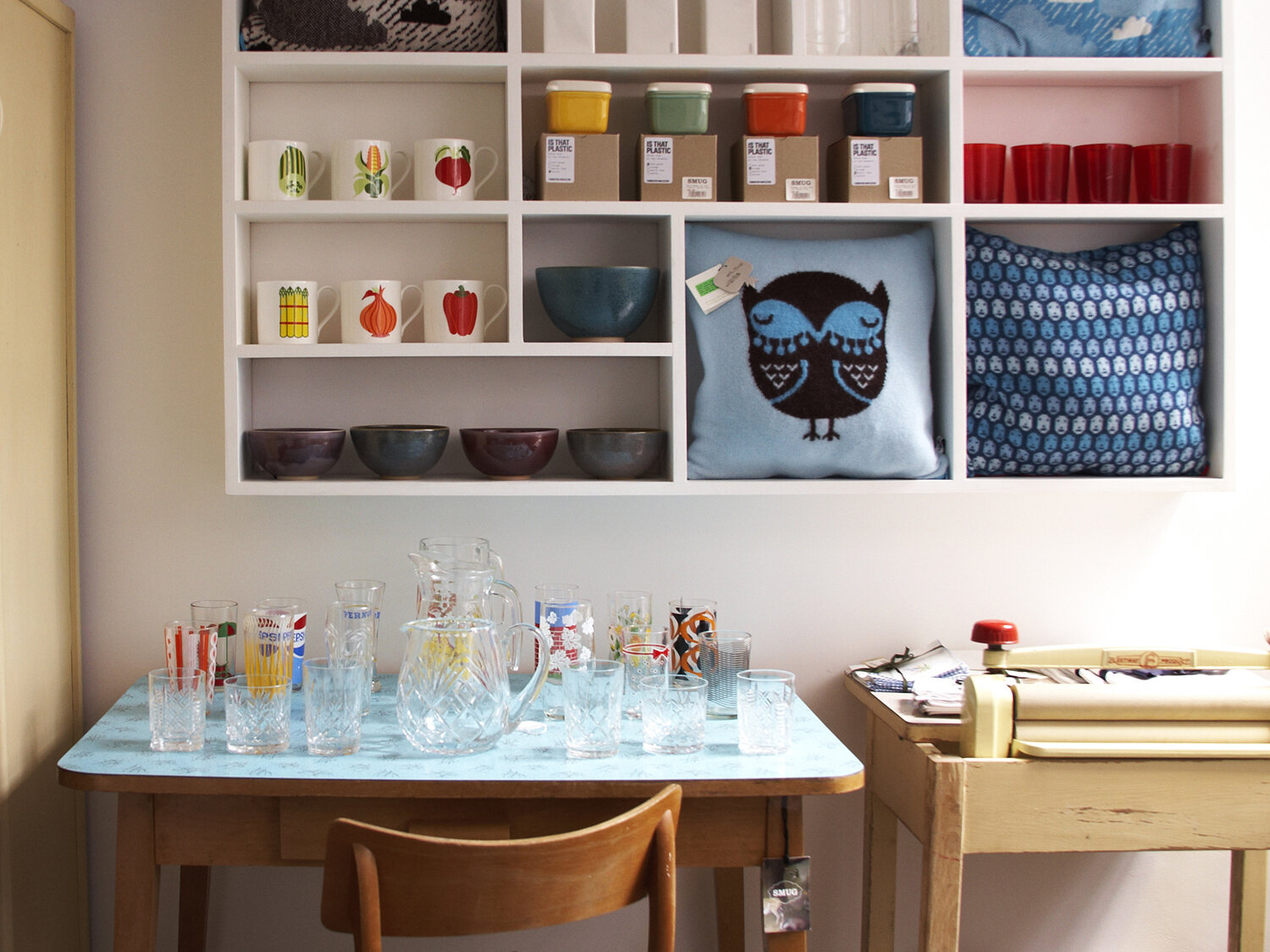 A massive painting by contemporary argentinean artist Hernán Salamanco that greets SMUG’s customers doesn’t just adhere to the colour palette – “yellows, blues and putties” – but also defines what comes into the shop too. “The painting works with everything I buy, basically. I’m even designing some SMUG socks at the moment, which are all taken from that colour palette.”An eye for colour and style runs in Lizzie’s family: her father and brother are art dealers, and now run a contemporary collection in the top floor of Lizzie’s building. Her mother’s in on the game too, helping out with SMUG on Fridays. (“It’s really nice,” she says, laughing. “It means I actually get a lunch break on Fridays, because every other day, I don’t.”) The family atmosphere extends to Lizzie’s living quarters: her home is actually the top floor of her parents’ house. Although she has her own Islington flat that she lets out to tenants, Lizzie admits that the Evans family headquarters – “a big town house on a cul de sac with a huge garden” – is too nice to refuse. “I’ve lived there since I was 11,” she says.“I was about to move out after uni, but i’ve basically stayed at home so I can afford to set up the shop.” She plans to move out next year, but jokes that it’s tempting to stay there for ever.However, Lizzie’s abode is different from the rest of the house. While most of the house is very traditional with very high ceilings, floorboards and flagstone floors, the top floor is in the eaves of the house, and has low sloping ceilings. “Originally, it was a boring space where you would’ve had your servants years and years ago. So I’ve adapted it and made it more modern and quirky.”
A massive painting by contemporary argentinean artist Hernán Salamanco that greets SMUG’s customers doesn’t just adhere to the colour palette – “yellows, blues and putties” – but also defines what comes into the shop too. “The painting works with everything I buy, basically. I’m even designing some SMUG socks at the moment, which are all taken from that colour palette.”An eye for colour and style runs in Lizzie’s family: her father and brother are art dealers, and now run a contemporary collection in the top floor of Lizzie’s building. Her mother’s in on the game too, helping out with SMUG on Fridays. (“It’s really nice,” she says, laughing. “It means I actually get a lunch break on Fridays, because every other day, I don’t.”) The family atmosphere extends to Lizzie’s living quarters: her home is actually the top floor of her parents’ house. Although she has her own Islington flat that she lets out to tenants, Lizzie admits that the Evans family headquarters – “a big town house on a cul de sac with a huge garden” – is too nice to refuse. “I’ve lived there since I was 11,” she says.“I was about to move out after uni, but i’ve basically stayed at home so I can afford to set up the shop.” She plans to move out next year, but jokes that it’s tempting to stay there for ever.However, Lizzie’s abode is different from the rest of the house. While most of the house is very traditional with very high ceilings, floorboards and flagstone floors, the top floor is in the eaves of the house, and has low sloping ceilings. “Originally, it was a boring space where you would’ve had your servants years and years ago. So I’ve adapted it and made it more modern and quirky.” 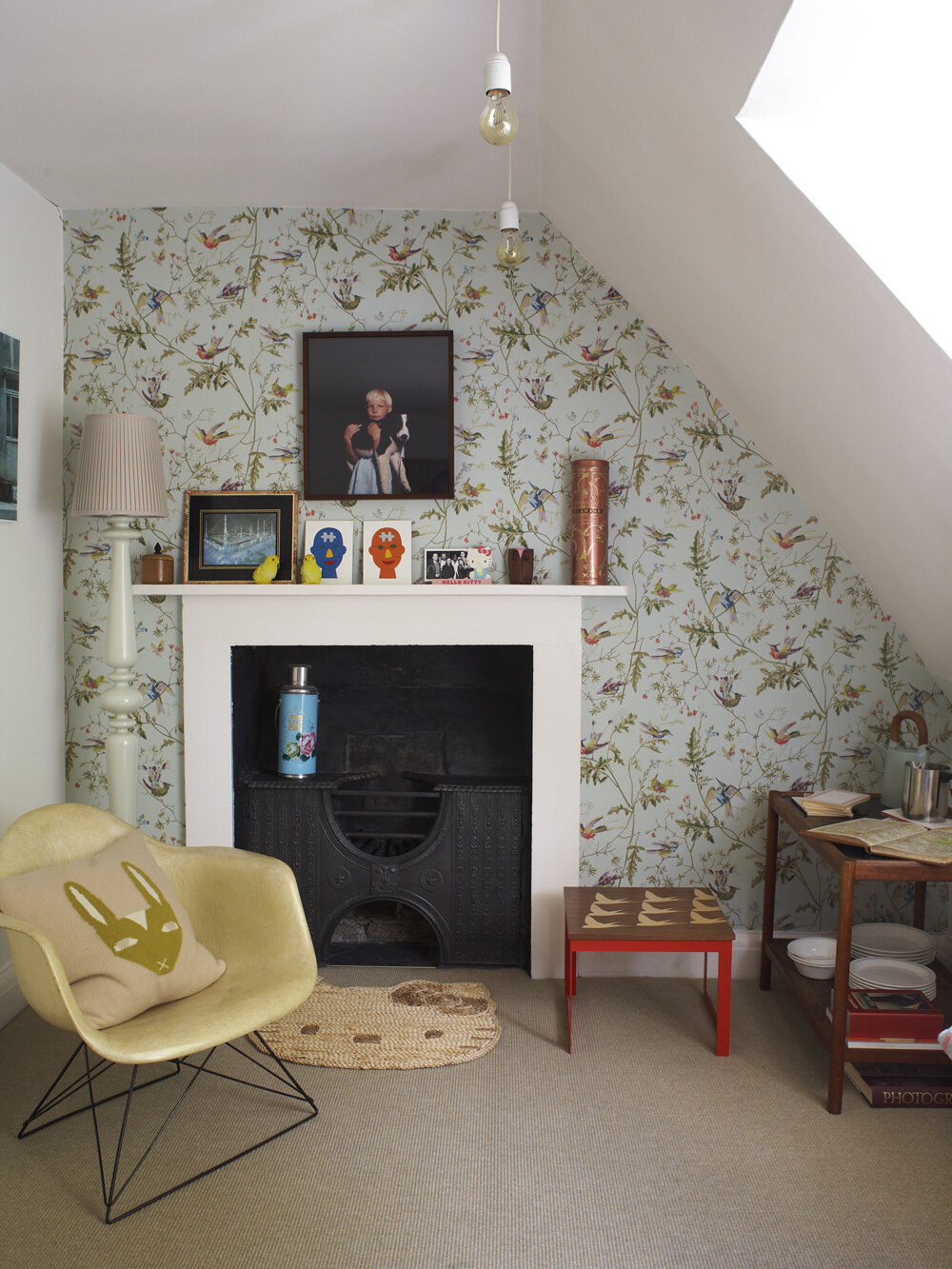 Her favourite part is an ornament-filled sitting room that she refers to as “my little SMUG”. when she’s complimented about the light turquoise bluebird wallpaper featured here, she laughs. “it’s just Cole and Son,” she says, referring to an old english wallpaper brand that was established in 1875. And while she keeps separate space from her folks downstairs, she adds that the ground-floor toilet is covered in wallpaper too. “The design is called best in show, and it’s cream with big flock dogs all over it. I’ve always got my eye open for very strange wallpaper.”In the same sitting room, on top of the old fireplace, there is a framed photograph by a south african artist called Trevor Appleson. “he went to Cape Town, took a black screen, some lights and his camera. On the beaches, he asked homeless people who live there if they’d like their photograph taken. This is an a little orphan homeless boy and his dog that he’s photographed in Cape Town, an amazing shot.” There are, of course, also items lifted straight from SMUG stock, like the Donna Wilson “bunny” cushion that sits on her chair, and are also for sale. At the moment, however, Lizzie’s favourite SMUG items for sale are picnic blankets made entirely from the leftovers of a welsh wool company that retail for £28. “They used to throw away these pieces and now they’ve made them into picnic blankets. Whatever yarn they have leftover they put on the loom, thread it through so they’re all different from each other, and they’ve got loads of different colours in the tassels coming out the end. they’re gorgeous, completely recycled and unique from each other.”
Her favourite part is an ornament-filled sitting room that she refers to as “my little SMUG”. when she’s complimented about the light turquoise bluebird wallpaper featured here, she laughs. “it’s just Cole and Son,” she says, referring to an old english wallpaper brand that was established in 1875. And while she keeps separate space from her folks downstairs, she adds that the ground-floor toilet is covered in wallpaper too. “The design is called best in show, and it’s cream with big flock dogs all over it. I’ve always got my eye open for very strange wallpaper.”In the same sitting room, on top of the old fireplace, there is a framed photograph by a south african artist called Trevor Appleson. “he went to Cape Town, took a black screen, some lights and his camera. On the beaches, he asked homeless people who live there if they’d like their photograph taken. This is an a little orphan homeless boy and his dog that he’s photographed in Cape Town, an amazing shot.” There are, of course, also items lifted straight from SMUG stock, like the Donna Wilson “bunny” cushion that sits on her chair, and are also for sale. At the moment, however, Lizzie’s favourite SMUG items for sale are picnic blankets made entirely from the leftovers of a welsh wool company that retail for £28. “They used to throw away these pieces and now they’ve made them into picnic blankets. Whatever yarn they have leftover they put on the loom, thread it through so they’re all different from each other, and they’ve got loads of different colours in the tassels coming out the end. they’re gorgeous, completely recycled and unique from each other.” 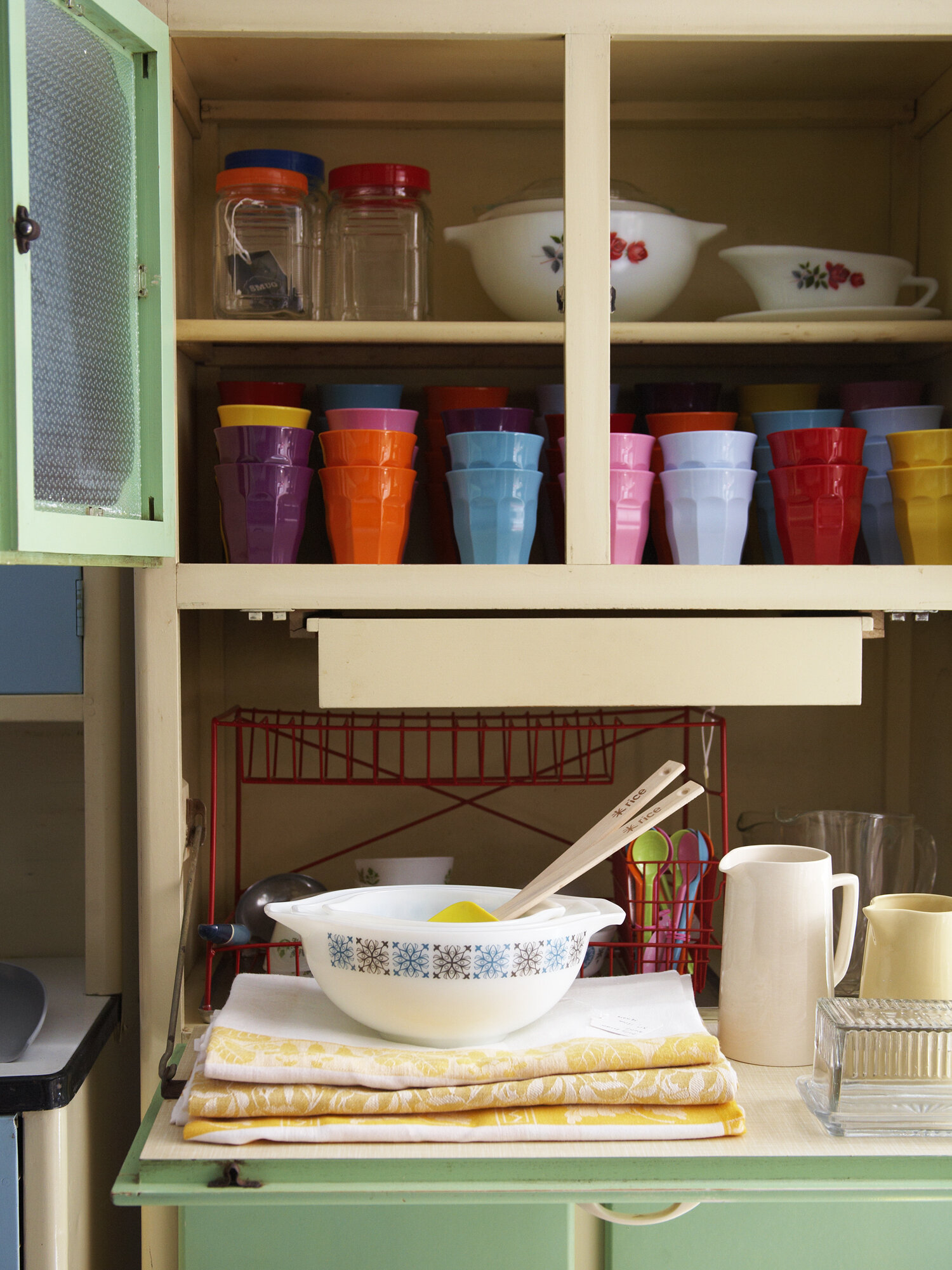 One of her bestselling items are the freestanding 1950s seagrass and blue kitchen units that double as stock displays. Called maid servers, Lizzie says they are difficult to source since they were discarded with the advent of fitted kitchens. “Everybody had them before everybody went modern,” she says, “then people literally cut them up and threw them away.“But they’re so practical and gorgeous. The colours they use are so easy to slip into any interior you have.” Lizzie sources the maid servers from people who’ve cared for them over the years or restored it themselves, before selling them at SMUG for between £350 to £600. “It’s very much a treasure trove,” Lizzie says. “Things are placed together as they would be in a home. The most commonly said thing is, ‘Oh, I wish I could live here! Is your house above the shop?’ They really feel like it’s like a home.” Since she has opened SMUG, she has even been speaking to potential clients who want Lizzie for her design chops. “People have been coming into the space saying, ‘well, I want my home to look like that’. So I can help make that happen.”
One of her bestselling items are the freestanding 1950s seagrass and blue kitchen units that double as stock displays. Called maid servers, Lizzie says they are difficult to source since they were discarded with the advent of fitted kitchens. “Everybody had them before everybody went modern,” she says, “then people literally cut them up and threw them away.“But they’re so practical and gorgeous. The colours they use are so easy to slip into any interior you have.” Lizzie sources the maid servers from people who’ve cared for them over the years or restored it themselves, before selling them at SMUG for between £350 to £600. “It’s very much a treasure trove,” Lizzie says. “Things are placed together as they would be in a home. The most commonly said thing is, ‘Oh, I wish I could live here! Is your house above the shop?’ They really feel like it’s like a home.” Since she has opened SMUG, she has even been speaking to potential clients who want Lizzie for her design chops. “People have been coming into the space saying, ‘well, I want my home to look like that’. So I can help make that happen.”

